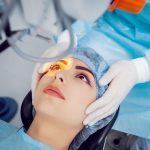What is achalasia?
Achalasia is a condition that causes problems with swallowing. It can also cause regurgitation (bringing food back into your mouth), chest pain and weight loss.
The lower oesophageal sphincter is the valve that controls how food passes into your stomach.
Achalasia is where the valve does not relax properly.

What are the benefits of surgery?
The aim is to make it easier for you to swallow. The benefits will often last for a lifetime.
Are there any alternatives to surgery?
The alternatives to surgery will usually give only temporary relief from your symptoms.
- changing the way you eat
- changing what you eat
- medication
- botox injections
- balloon dilatation
A new procedure called peroral endoscopic myotomy (POEM) is available in a few centres.
What does the operation involve?
Achalasia is treated surgically by cutting the muscle of the lower oesophageal sphincter. This should open the passage between your oesophagus and stomach, making it easier for you to swallow.
The operation is performed under a general anaesthetic and usually takes an hour to 90 minutes.
Your surgeon will use laparoscopic (keyhole) surgery, as this is associated with less pain, less scarring and a faster return to normal activities.
They will make several small cuts on your abdomen so they can insert tubes (ports) into your abdomen.
Your surgeon will insert surgical instruments through the ports along with a telescope so they can see inside your abdomen and perform the operation.
Your surgeon will cut and spread apart the layers of muscle of the lower oesophageal sphincter and lower end of your oesophagus.
How can I prepare myself for the operation?
If you smoke, stopping smoking now may reduce your risk of developing complications and will improve your long-term health.
Try to maintain a healthy weight. You have a higher risk of developing complications if you are overweight.
Regular exercise should help to prepare you for the operation, help you to recover and improve your long-term health. Before you start exercising, ask the healthcare team or your GP for advice.
Speak to the healthcare team about any vaccinations you might need to reduce your risk of serious illness while you recover. When you come into hospital, practise hand washing and wear a face covering when asked.
What complications can happen?
Some complications can be serious and can even cause death.
General complications of any operation
- bleeding
- infection of the surgical site (wound)
- allergic reaction to the equipment, materials or medication
- developing a hernia in the scar
- blood clot in your leg
- blood clot in your lung
- chest infection
Specific complications of this operation
Keyhole surgery complications
- surgical emphysema (a crackling sensation in your skin caused by trapped carbon dioxide)
- damage to structures such as your bowel, liver or blood vessels
- developing a hernia near one of the cuts
- gas embolism
Cardiomyotomy complications
- making a hole in your oesophagus or stomach (perforation)
- difficulty swallowing
- developing acid reflux, which causes a burning sensation in your chest
- pneumothorax, where air escapes into the space around your lung
Consequences of this procedure
- pain
- unsightly scarring of your skin
How soon will I recover?
You should be able to go home after 1 to 3 days.
You should be able to return to work after 2 weeks, depending on how much surgery you need and your type of work.
Regular exercise should help you to return to normal activities as soon as possible. Before you start exercising, ask the healthcare team or your GP for advice.
Most people make a good recovery.



